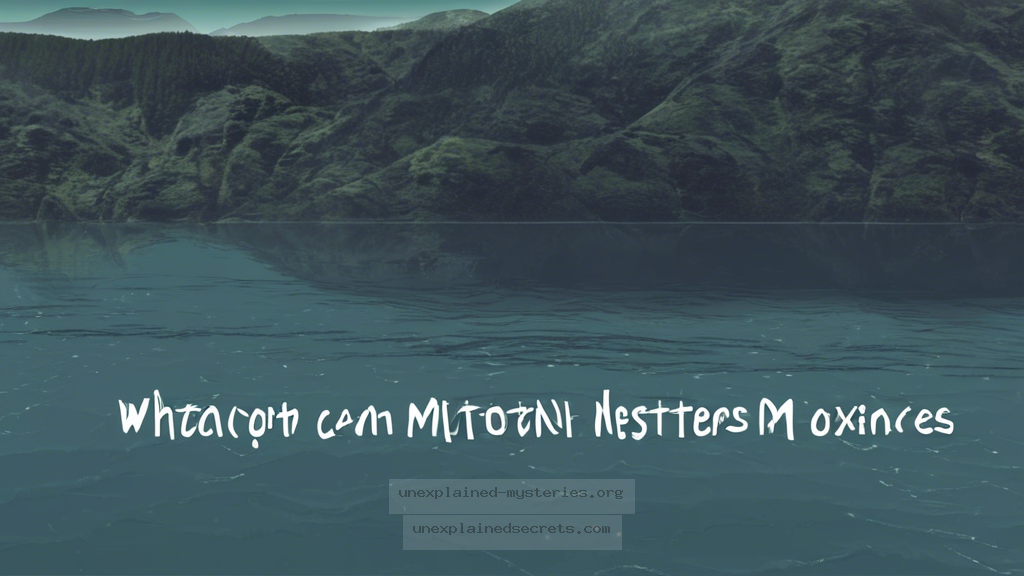What Can Sonar Detections Tell Us About the Loch Ness Monster’s Existence?
What Can Sonar Detections Tell Us About the Loch Ness Monster’s Existence?
The Loch Ness Monster, often affectionately dubbed “Nessie,” has captivated imaginations for centuries. As one of the most enduring legends in cryptozoology, the mystery surrounding the Loch Ness Monster raises critical questions about its existence, particularly in light of modern technological advancements such as sonar detection. This blog post will delve into the intriguing question: What can sonar detections tell us about the Loch Ness Monster’s existence? Our exploration will cover historical accounts, scientific expeditions, core concepts behind sonar technology, and the implications of sonar data on the ongoing quest to uncover the truth about Nessie.
Historical Context of the Loch Ness Monster
The Loch Ness Monster legend traces back to ancient times, with the first recorded sighting occurring in 565 AD, when Saint Columba allegedly encountered a “water beast” in the loch. However, the modern fascination began in the 1930s, notably with the publication of the famous “Surgeon’s Photograph” in 1934, which purportedly showed Nessie gliding through the water. This photograph sparked a media frenzy and led to numerous expeditions aimed at capturing evidence of the creature’s existence.
The Loch Ness is a large, deep freshwater loch in the Scottish Highlands, reaching depths of up to 230 meters (755 feet). This unique environment has made it a prime location for cryptozoological investigations. Over the decades, various sonar studies have been conducted, contributing significantly to our understanding of what might be lurking beneath the surface.
The Role of Sonar Technology
Sonar, an acronym for Sound Navigation and Ranging, is a technology that uses sound waves to detect and locate objects underwater. There are two primary types of sonar: active and passive. Active sonar emits sound waves and listens for their echoes, while passive sonar listens for sounds emitted by objects in the water. In the context of Loch Ness, both types have been utilized in attempts to locate Nessie.
Active sonar has played a crucial role in mapping the loch’s underwater terrain and identifying potential creatures or anomalies. For instance, the 2018 expedition led by the Loch Ness Project employed an advanced sonar system known as the “multi-beam sonar,” which can create a detailed 3D map of the underwater landscape.
Key Sonar Expeditions and Findings
Over the years, several notable sonar expeditions have attempted to shed light on the Loch Ness Monster’s existence. One of the most significant was the 1972 “Operation Deepscan,” where a fleet of boats equipped with sonar technology scanned the loch’s depths. The operation discovered several unidentified objects, but no conclusive evidence of a creature resembling Nessie was documented.
In 2018, the Loch Ness Project embarked on a modern expedition utilizing advanced sonar technology. The team recorded multiple anomalies, which they believed could potentially be large fish or even debris. However, the data left much open to interpretation, fueling ongoing debate about what lies beneath the surface.
What Sonar Detections Reveal
Key Insights: Sonar detections have revealed various underwater anomalies in Loch Ness, fueling speculation about their origins. However, no confirmed evidence of a large creature has emerged from sonar studies.
Sonar detections have primarily identified three categories of underwater objects: large fish, debris, and unidentified objects. Large fish, such as pike or eels, could account for some sightings attributed to Nessie. In fact, the loch is home to various species of fish that can grow to impressive sizes.
Furthermore, sonar technology has detected numerous submerged logs and other debris, which can create echoes similar to those associated with larger creatures. This phenomenon often leads to misinterpretations of sonar data, sparking excitement among enthusiasts and researchers alike.
Alternative Perspectives on Sonar Findings
While sonar data can provide intriguing insights, it is essential to approach these findings with a critical mindset. Skeptics argue that sonar detections often lead to overinterpretation. For example, the unidentified anomalies detected in the loch could very well be the result of natural geological formations rather than evidence of a mythical creature.
Moreover, some researchers contend that the sheer size and depth of Loch Ness make it improbable for a large creature to remain undetected for so long. They argue that if such a creature existed, it would likely leave more substantial evidence, such as carcasses or consistent sightings.
Common Misconceptions About Sonar Technology
Common Misconceptions: One frequent misconception is that sonar can definitively identify the Loch Ness Monster. In reality, sonar is a tool for detection and mapping, not for identification.
Many people assume that sonar technology can conclusively identify specific creatures, but this is far from the truth. Sonar systems can detect objects and provide data regarding their size and shape, but they do not offer definitive identification. The interpretation of sonar data relies heavily on the expertise of the operators and their understanding of the underwater environment.
Best Practices for Investigating the Loch Ness Monster
For those interested in investigating the Loch Ness Monster, certain best practices can enhance the likelihood of meaningful discoveries. First, it is critical to prioritize scientific methods and data collection over sensationalism. Engaging with reputable experts in sonar technology and marine biology can provide invaluable insights.
Additionally, conducting collaborative research with established institutions can help ensure that findings are taken seriously within the scientific community. Researchers should also remain open to various explanations for sonar detections, including the possibility of large fish or geological formations.
Future Developments and Ongoing Research
The quest for the Loch Ness Monster continues, with ongoing research and technological advancements paving the way for new discoveries. Future expeditions are likely to employ even more sophisticated sonar technology, such as autonomous underwater vehicles (AUVs) equipped with high-resolution imaging systems. These systems can provide more detailed insights into the loch’s depths and potentially uncover new evidence.
Furthermore, the integration of genetic sampling methods may yield new avenues of research. Scientists could analyze environmental DNA (eDNA) from the loch to identify the presence of various species, potentially shedding light on whether any unidentified large creatures inhabit the waters.
Conclusion: The Mystery of the Loch Ness Monster Persists
In conclusion, sonar detections offer a fascinating glimpse into the mysteries of Loch Ness, yet they have not provided conclusive evidence of the Loch Ness Monster’s existence. While sonar technology can reveal unidentified anomalies, these findings often lead to speculation rather than definitive answers. As research continues and technology evolves, the enigma of Nessie remains alive, captivating the imaginations of both believers and skeptics alike.
Ultimately, the Loch Ness Monster serves as a reminder of the unexplained wonders of our world. Whether you are a passionate believer or a curious skeptic, the quest to uncover the truth about Nessie is a journey that blends science, folklore, and the tantalizing possibility of the unknown.
Other Articles
Recent Posts
- What Happened to Flight MH370? The Conspiracy Theories That Still Haunt Us
- What Secrets Lurk Within the Walls of the Infamous Trans-Allegheny Lunatic Asylum?
- What Evidence Supports the Existence of Bigfoot in the Pacific Northwest?
- What Happened to the Indus Valley Civilization? Unraveling the Mysteries of Ancient Urban Life
- Can Telepathy Be Scientifically Proven Through Laboratory Evidence?







